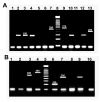Two or more enteropathogens are associated with diarrhoea in Mexican children
- PMID: 18162140
- PMCID: PMC2246149
- DOI: 10.1186/1476-0711-6-17
Two or more enteropathogens are associated with diarrhoea in Mexican children
Abstract
Background: Diarrhoeal diseases constitute a major public health problem, particularly in the developing world, where the rate of mortality and morbidity is very high. The purpose of this study was to conduct a 2 years and 3 months study in order to determine the prevalence of five enteropathogen diarrheogenic agents in Mexico City.
Methods: Faecal samples were obtained from 300 Mexican children diagnosed as positive for diarrhoea, aged > 2 to < 12 years old, and from 80 children matched for age but with no symptoms of the disease (control group). Two multiplex PCR were used to detect Escherichia coli, Salmonella spp., and Shigella spp. In addition, the two protozoan parasites Entamoeba histolytica/Entamoeba dispar and Giardia intestinalis were detected by conventional methods.
Results: All diarrhoeal samples were positive for one or more enteropathogens. The most common enteropathogens in diarrhoeal samples were E. histolytica/E. dispar (70.3%), Salmonella (ohio 28.3%; typhimurium 16.3%; infantis 8%; anatum 0.6%; Newport 0.3%), G. intestinalis (33%), E. coli (ETEC 13.3%; EPEC 9.3%; VTEC 8.6%; EIEC 1%) and Shigella spp. (flexneri 1.6%, sonnei 1%). Infections by two (24%) three (16%) and four (12%) pathogens were observed.
Conclusion: This study revealed that 52% of the patients were infected by more than one enteropathogen, notably E. histolitica/E. dispar and Salmonella ohio. These results are useful for clinicians to improve the empiric treatment used in such cases.
Figures


Similar articles
-
Enteropathogens in adult patients with diarrhea and healthy control subjects: a 1-year prospective study in a Swedish clinic for infectious diseases.Clin Infect Dis. 2000 May;30(5):770-8. doi: 10.1086/313770. Epub 2000 May 18. Clin Infect Dis. 2000. PMID: 10816147
-
Clinical, microbiological and antibiotic susceptibility patterns of diarrhoea in Korem, Ethiopia.J Trop Med Hyg. 1988 Dec;91(6):296-301. J Trop Med Hyg. 1988. PMID: 2905012
-
A study of the aetiological agents of childhood diarrhoea in Lagos, Nigeria.J Med Microbiol. 1994 Jan;40(1):10-4. doi: 10.1099/00222615-40-1-10. J Med Microbiol. 1994. PMID: 8289209
-
Enteropathogens associated with acute diarrhoeal diseases.Indian J Public Health. 1994 Apr-Jun;38(2):29-32. Indian J Public Health. 1994. PMID: 7835992 Review.
-
Diarrhoeal disease: current concepts and future challenges. Molecular biological approaches to the epidemiology of diarrhoeal diseases in developing countries.Trans R Soc Trop Med Hyg. 1993 Dec;87 Suppl 3:3-5. doi: 10.1016/0035-9203(93)90528-x. Trans R Soc Trop Med Hyg. 1993. PMID: 8108846 Review.
Cited by
-
Antiprotozoal, Antibacterial and Antidiarrheal Properties from the Flowers of Chiranthodendron pentadactylon and Isolated Flavonoids.Pharmacogn Mag. 2017 Apr-Jun;13(50):240-244. doi: 10.4103/0973-1296.204564. Epub 2017 Apr 18. Pharmacogn Mag. 2017. PMID: 28539715 Free PMC article.
-
Molecular basis of virulence in clinical isolates of Escherichia coli and Salmonella species from a tertiary hospital in the Eastern Cape, South Africa.Gut Pathog. 2011 Jun 10;3(1):9. doi: 10.1186/1757-4749-3-9. Gut Pathog. 2011. PMID: 21663681 Free PMC article.
-
Infection-Induced Intestinal Dysbiosis Is Mediated by Macrophage Activation and Nitrate Production.mBio. 2019 May 28;10(3):e00935-19. doi: 10.1128/mBio.00935-19. mBio. 2019. PMID: 31138751 Free PMC article.
-
Epidemiology and geographical distribution of enteric protozoan infections in sydney, australia.J Public Health Res. 2014 Aug 25;3(2):298. doi: 10.4081/jphr.2014.298. eCollection 2014 Jul 2. J Public Health Res. 2014. PMID: 25343139 Free PMC article.
-
Optimized microbial DNA extraction from diarrheic stools.BMC Res Notes. 2012 Dec 28;5:702. doi: 10.1186/1756-0500-5-702. BMC Res Notes. 2012. PMID: 23273000 Free PMC article.
References
-
- Alper J. Date gaps need bridging to assess infectious gastrointestinal diseases. ASM News. 2003;69:65–68.
-
- Secretaría de Salud , Mexico Estadísticas de mortalidad en México: muertes registradas en el año 2003. Salud Pública Méx. 2005;47:171–187. - PubMed
-
- Foodborne diseases, emerging http://www.who.int/mediacentre/factsheets/fs124/en/
Publication types
MeSH terms
LinkOut - more resources
Full Text Sources
Medical
Molecular Biology Databases
Miscellaneous

